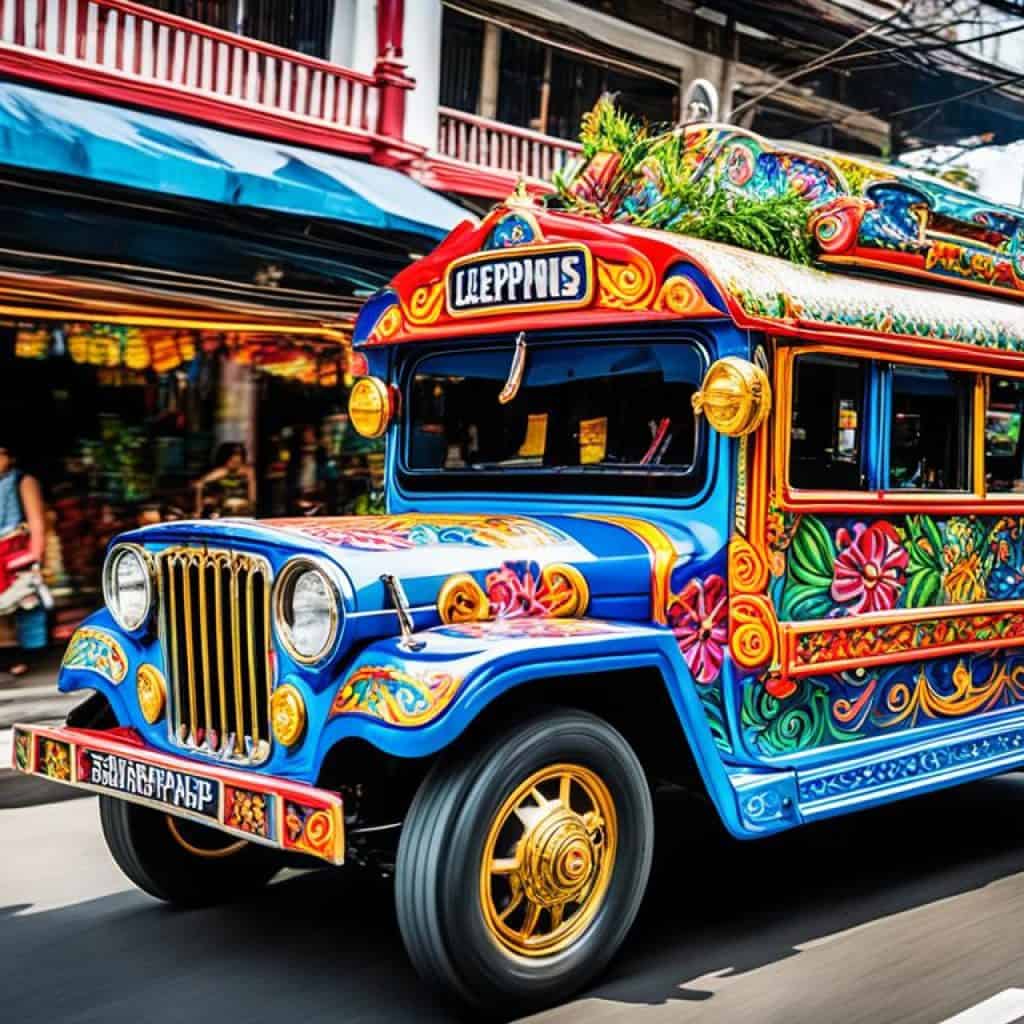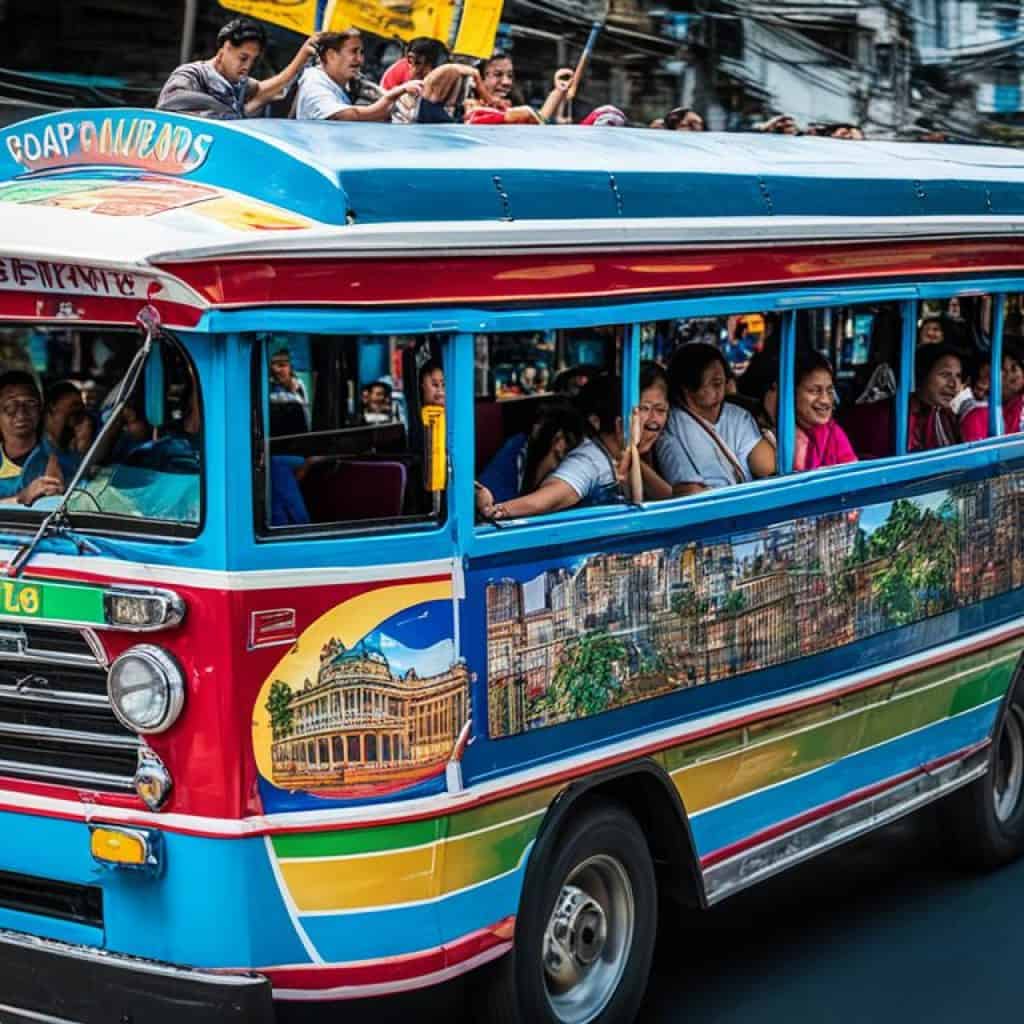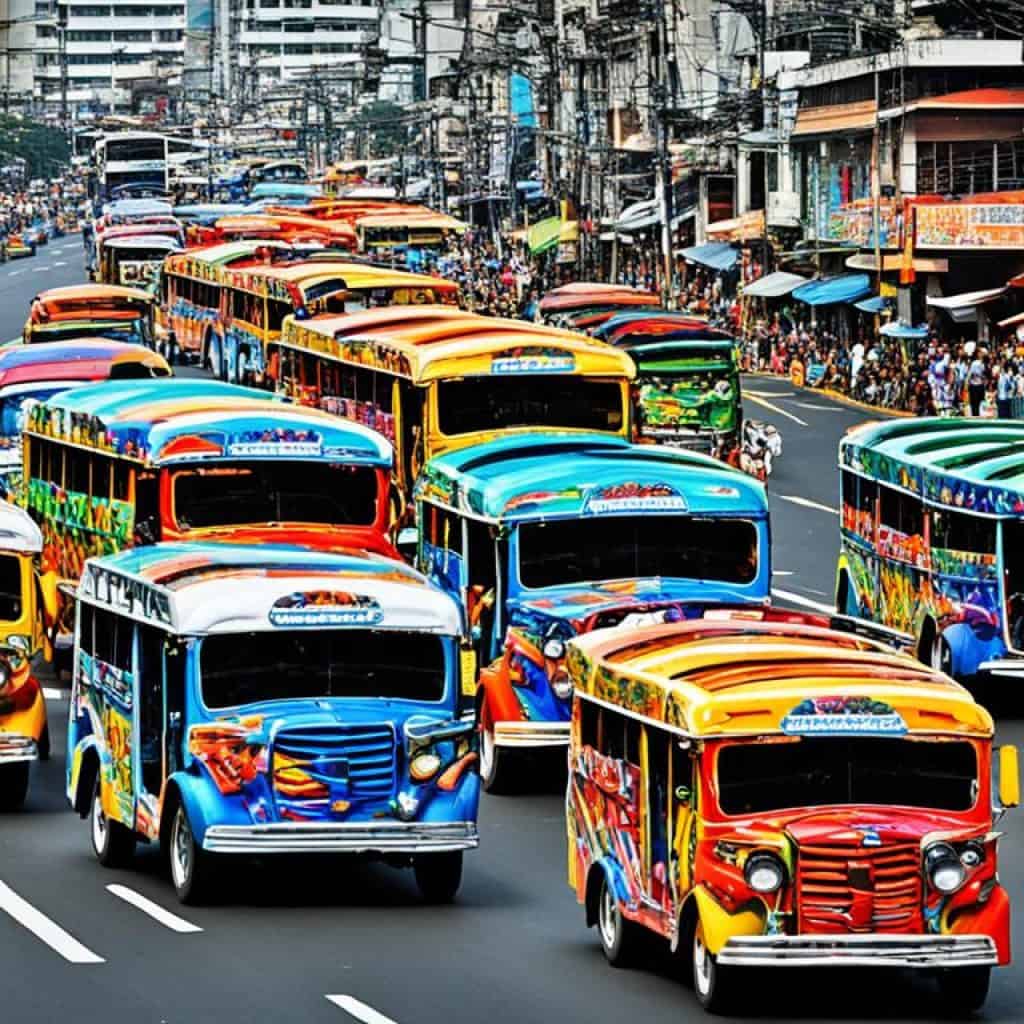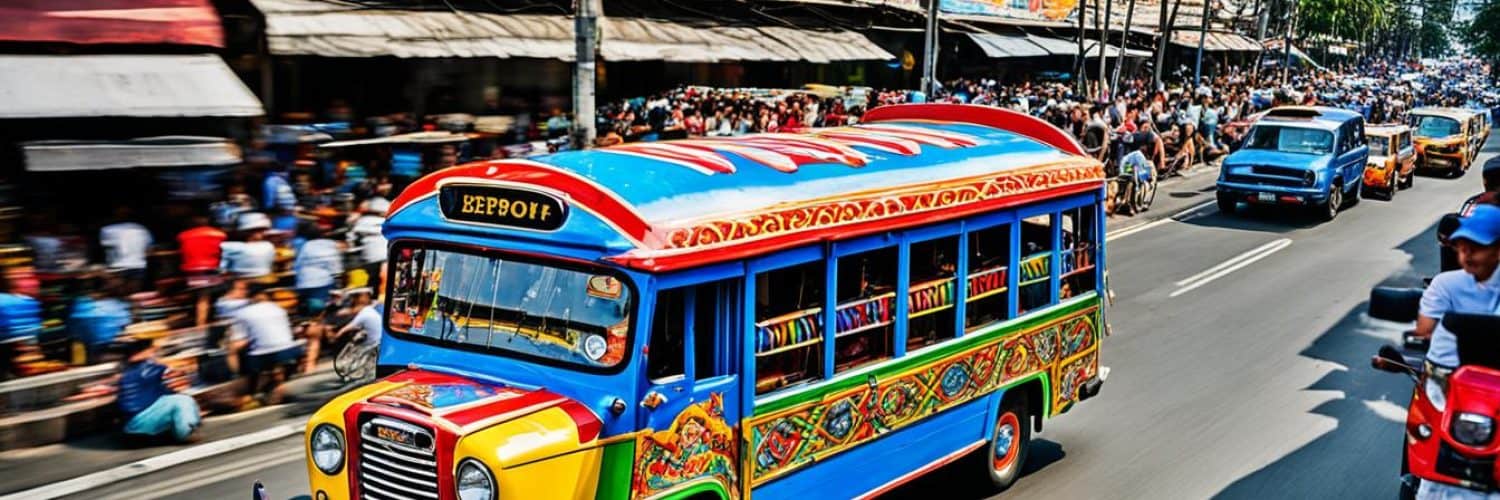Have you ever wondered about the vibrant and eye-catching Jeepneys that roam the streets of the Philippines? How did these unique vehicles become such an integral part of Filipino culture? And what do they symbolize?
The Jeepney is more than just a mode of transportationâit represents the resilience, ingenuity, and community spirit of the Filipino people. Each Jeepney tells a story through its design, decorations, and the interactions that take place inside. Join us as we delve into the history, significance, and challenges faced by the Jeepney in the Philippines.
Key Takeaways:
- Jeepneys are an iconic symbol of Filipino culture and represent the resilience and spirit of the Filipino people.
- These unique vehicles have a rich history, originating from surplus military jeeps after World War II.
- Jeepneys are known for their vibrant design and elaborate decorations, showcasing the creativity and personality of their owners.
- Passengers in Jeepneys often engage in conversations, impromptu singing, and acts of kindness, fostering a sense of community.
- The Jeepney industry provides employment and contributes to the local economy, while modernization efforts aim to address safety and environmental concerns.
History of the Jeepney
After World War II, surplus military jeeps from the United States were repurposed by resourceful Filipinos to create an affordable mode of transportation. These jeeps, known as Philippine jeepneys, played a crucial role in meeting the country’s growing public transportation needs. The ingenuity of the Filipino people transformed these military vehicles into iconic symbols of Philippine culture.
The surplus military jeeps were lengthened and modified with roofs to accommodate more passengers, making them suitable for public utility purposes. The transformation did not stop there. Filipinos adorned the jeepneys with vibrant artistic elements, showcasing their creativity and adding a touch of cultural expression. Intricate paintings, colorful exteriors, and ornate accessories turned these vehicles into rolling works of art.
The Philippine jeepney represents the resourcefulness, resilience, and spirit of the Filipino people. It is a symbol of their ability to transform military surplus into a vital part of daily life and community interaction. The history of the jeepney showcases the Filipino spirit of ingenuity and the deep connection between the people and their transportation.
| Key points about the history of the jeepney: |
|---|
| The jeepney originated from surplus military jeeps from the United States |
| They were transformed into public utility vehicles by lengthening and modifying them |
| Artistic elements and vibrant decorations were added to represent Filipino culture |
| Jeepneys became a symbol of Filipino resourcefulness and community spirit |
Design and Decorations of the Jeepney
The Philippine jeepney is a true work of art, showcasing vibrant colors, intricate designs, and ornate accessories. Each jeepney is a unique reflection of its owner’s creativity and personality, making it a captivating sight on the streets of the Philippines.
The design of the jeepney is characterized by elaborate paintings that adorn its exterior. These paintings often depict scenes from Filipino culture, history, and nature, showcasing the country’s rich heritage. From stunning landscapes to historical landmarks, the artwork on jeepneys represents the diverse beauty of the Philippines.
Additionally, the use of vibrant colors is a prominent feature of jeepney design. Bright reds, oranges, blues, and yellows bring these vehicles to life, creating a visual spectacle that captures the attention of passersby. The bold color palette of the jeepney reflects the lively and vibrant spirit of the Filipino people.
Ornate accessories further enhance the aesthetic appeal of the jeepney. Metal sculptures, such as roosters or horses, are intricately crafted and prominently displayed on the vehicle’s hood. Tassels and curtains adorn the windows, adding a touch of elegance and charm. These accessories not only contribute to the visual appeal of the jeepney but also showcase the craftsmanship and attention to detail of Filipino artisans.
The design and decorations of the jeepney are deeply rooted in Filipino art and culture. It is a testament to the creativity, pride, and love for beauty that is ingrained in the Filipino identity. The jeepney’s aesthetic appeal not only serves as a form of self-expression for its owners but also as a source of joy and admiration for the Filipino people.

Jeepney Design Elements:
| Design Element | Description |
|---|---|
| Vibrant Colors | The jeepney is known for its use of bold and vibrant colors such as red, orange, blue, and yellow. These colors add a striking visual appeal to the vehicle and represent the lively spirit of the Filipino people. |
| Intricate Paintings | Jeepneys are adorned with elaborate paintings that depict scenes from Filipino culture, history, and nature. These paintings showcase the country’s rich heritage and serve as a form of artistic expression. |
| Ornate Accessories | Metal sculptures, tassels, and curtains are common accessories found on jeepneys. These ornate accessories add a touch of elegance and charm to the vehicle, showcasing Filipino craftsmanship and attention to detail. |
Significance of the Jeepney in Filipino Culture
The jeepney holds a special place in the hearts of Filipinos, symbolizing their resilience, ingenuity, and sense of community. These vehicles embody the Jeepney culture that is deeply rooted in the Filipino spirit.
When passengers step onto a jeepney, they enter a shared space where connections are fostered and community spirit thrives. It is not uncommon to witness impromptu singing and laughter, as passengers come together to create a joyful atmosphere during the ride.
“The jeepney is more than just a mode of transportation; it is a vehicle that brings people together, encouraging conversations, storytelling, and acts of kindness. It creates a sense of belonging and unity among passengers,” says Maria Santos, a regular jeepney commuter.
The Jeepney culture also extends beyond the passengers and drivers. The jeepney industry provides employment opportunities for drivers, artists, and mechanics who maintain and customize these vehicles. The industry contributes to the local economy and attracts tourists who are fascinated by this unique cultural icon.
Jeepneys, with their vibrant colors and artistic designs, have become synonymous with Filipino culture. They have become an enduring symbol of the Filipino spirit’s creativity, resilience, and community values.
Community Spirit & Acts of Kindness
The jeepney culture fosters community spirit and acts of kindness among passengers. Whether it’s helping someone find their stop, sharing a seat, or engaging in friendly conversations, jeepney rides often bring out the best in people.
One passenger, Javier Cruz, shares his experience: “I’ll never forget the time I left my wallet in a jeepney. The driver went out of his way to return it to me, refusing any reward. It was a true testament to the kindness and honesty that jeepney culture embodies.”
These small acts of kindness are a reflection of the Filipino spirit and the strong sense of community that is deeply ingrained in the culture.
The Cultural Icon of the Philippines
The jeepney, with its unique design and cultural significance, is often showcased in tourism exhibitions and can be found in souvenir shops across the Philippines. It has become an iconic symbol that represents Filipino pride.
“The jeepney is more than just a transportation vehicle; it is a cultural icon that represents the vibrant Filipino spirit. Its presence on the streets of Manila and other cities is a constant reminder of the resilience and adaptability of the Filipino people,” says Juan Santos, a cultural historian.
With its rich history, community spirit, and unique design, the jeepney continues to capture the hearts and imaginations of Filipinos and visitors alike. It serves as a powerful symbol of the Filipino spirit and a testament to the ingenuity and unity of the Filipino people.
Challenges and Modernization of the Jeepney
As an iconic symbol of Filipino culture, the jeepney has faced challenges in the modern era. With concerns about safety, emissions, and traffic congestion, the government has implemented regulations and encouraged modernization efforts. This section explores the push for Jeepney modernization to ensure sustainability and address environmental concerns.
Government Regulations
Recognizing the need for safer and more environmentally friendly public transportation, the Philippine government has introduced regulations to improve the jeepney industry. These regulations aim to enhance vehicle safety standards, reduce emissions, and optimize routes to alleviate traffic congestion. By enforcing modernization requirements, the government is working towards a more efficient and sustainable transportation system.
Electric-powered and Euro 4-compliant Jeepneys
One of the key components of Jeepney modernization is the shift towards electric-powered and Euro 4-compliant jeepneys. Electric-powered jeepneys offer a sustainable solution, reducing carbon emissions and contributing to a cleaner environment. Euro 4-compliant engines also help in minimizing pollutants released into the atmosphere. These advancements in technology bring a balance between preserving the cultural heritage of the jeepney and addressing the pressing need for sustainable transportation.
“The modernization of the jeepney industry is not just about meeting government regulations; it’s about creating a more sustainable and efficient transportation system for our country.” – Department of Transportation Representative
By embracing sustainable alternatives, the jeepney industry can evolve while maintaining its cultural significance. Electric-powered and Euro 4-compliant jeepneys provide an opportunity to efficiently transport passengers while reducing environmental impact. The modernization efforts aim to uplift the industry, improve passenger experience, and build a greener future for the Philippines.
Cultural Symbol and National Pride
The Jeepney is not just a mode of transportation; it is a symbol of Filipino culture and national pride. The vibrant and unique design of the Jeepney represents the Filipino spirit of ingenuity, tenacity, and unity. It is a testament to the creativity and resourcefulness of the Filipino people, who transformed surplus military jeeps into a cultural icon that embodies the essence of the Philippines.
This iconic vehicle is often showcased in tourism exhibitions, where visitors can marvel at its colorful exteriors, intricate paintings, and ornate accessories. The Jeepney has become synonymous with Filipino identity and is a source of pride for the nation. It is a symbol of the Filipino people’s resilience and their ability to turn adversity into beauty, making it a universally recognized cultural icon.
In souvenir shops, miniature replicas of the Jeepney serve as reminders of Filipino heritage, allowing both locals and tourists to take a piece of this cultural icon home with them. Its significance goes beyond being just a means of transportation; it represents the heart and soul of the Filipino people, their history, and their unyielding spirit.
“The Jeepney is a beacon of Filipino patriotism, a symbol of our history and the legacy left by the brave men and women who fought for our country. It is a testament to our resilience and our ability to adapt. It is a source of national pride, and it will forever be a part of our cultural fabric.”
Jeepney as a Cultural Ambassador
The Jeepney’s uniqueness and cultural significance have also gained international recognition. It has become an iconic symbol of the Philippines, attracting tourists from all over the world who are captivated by its vibrant colors, intricate designs, and rich cultural heritage.
The Jeepney serves as a powerful ambassador for Filipino culture, showcasing the nation’s creativity and passion to the global community. It is a tangible expression of Filipino pride and a reminder of the country’s rich history and heritage.
Jeepney Routes and Fare
Jeepneys in the Philippines operate on designated routes, with the routes often painted on their sides or displayed on their windshields. These colorful vehicles are a popular mode of public transportation, providing convenient access to various destinations across the country.
One of the unique features of jeepney routes is their flexibility. Unlike traditional bus systems, jeepneys can stop anywhere along their route to pick up or drop off passengers, making them a convenient choice for commuters.
When it comes to the fare, the prices vary depending on the distance traveled. For short urban rides, expect to pay around Php 7 to Php 10. However, for longer hauls, especially those covering substantial distances, the fare may be higher.
If you’re unfamiliar with the jeepney routes or fares, don’t hesitate to ask the driver or fellow passengers for guidance. The locals are usually friendly and willing to assist you in navigating the jeepney system.
To make your jeepney journey even more enjoyable and hassle-free, familiarize yourself with the popular routes and fare ranges available. This way, you’ll be able to explore the Philippines using this iconic mode of transportation without any worries.

Tips for Using Jeepney Routes
- Check the painted signs or displayed routes on the jeepney to ensure it’s headed in the direction you want to go.
- Don’t be shy to signal the driver when you want to get off. Simply say “Para po” to indicate your desired stop.
- Keep smaller bills or coins ready to pay your fare, as the driver may not always have change for larger bills.
- Be prepared for crowded conditions during peak hours, especially in urban areas.
“The jeepney routes offer a unique and vibrant way to experience public transportation in the Philippines. It’s a chance to immerse yourself in the local culture, interact with friendly locals, and explore the beautiful landscapes of this diverse country. Don’t miss the opportunity to hop on a jeepney and embark on an unforgettable journey.”
Jeepney Culture and Community Interaction
When riding a jeepney in the Philippines, it’s not just about getting from point A to point B. It’s an experience that immerses you in the vibrant Jeepney culture and fosters a sense of community. Passengers often engage in conversations, make connections, and form friendships during the ride, creating a lively and interactive atmosphere.
Inside a jeepney, you’ll witness impromptu singing, storytelling, and acts of kindness that are common occurrences. Passengers share stories, exchange opinions, and engage in friendly banter, creating bonds that go beyond the boundaries of the vehicle.
The unique seating arrangement, with passengers sitting closely side by side, encourages interaction among individuals from different walks of life. It’s an opportunity to learn from one another, expand horizons, and broaden perspectives.
“The jeepney is not just a mode of transportation; it’s a place where communities come together. It sparks conversations that foster understanding and unity.”
Jeepney rides become an avenue for experiencing the rich tapestry of Filipino culture firsthand. Conversations revolve around daily life, current events, food, music, and anything that sparks interest. Passengers willingly share their knowledge, stories, and traditions, creating an environment of cultural exchange.
Jeepney drivers often provide the perfect background music by tuning in to popular radio stations or playing nostalgic tunes that resonate with everyone on board. The shared experience of singing along unites strangers and brings joy to the journey.
The sense of community extends beyond conversation and singing. Acts of kindness are prevalent in jeepneys, with passengers helping one another–assisting the elderly, offering a helping hand to those carrying heavy loads, or giving up a seat to someone in need.
Jeepney Culture
In a culture deeply rooted in communal values, the Jeepney epitomizes the importance of community and human connection. It showcases the Filipino spirit of warmth, hospitality, and shared experiences. Through conversations and interactions, passengers build a sense of camaraderie that transforms a simple jeepney ride into an unforgettable journey.
Benefits of Jeepney Community Interaction
| Benefits | Description |
|---|---|
| Inclusive Environment | Passengers from all walks of life come together, fostering understanding and acceptance. |
| Cultural Exchange | Conversations provide opportunities to learn about different traditions, dialects, and customs. |
| Friendship Building | Passenger interactions often lead to friendships, creating a supportive network of connections. |
| Shared Joy and Laughter | Impromptu singing, storytelling, and acts of kindness bring joy and laughter to the journey. |
Economic Impact of the Jeepney Industry
The jeepney industry plays a crucial role in the economy of the Philippines, providing employment opportunities and contributing to the local economy. It serves as a livelihood for drivers, artists, and mechanics who are involved in the maintenance, customization, and operation of these unique vehicles.
Many families have dedicated their lives to the jeepney profession, passing down the trade from one generation to the next. It has become a source of pride and a way to support their families.
Moreover, the jeepney industry attracts tourists who are fascinated by this cultural symbol. These visitors not only contribute to the local economy by engaging in various tourist activities but also by actively supporting the jeepney industry. They often take joyrides, purchase souvenirs, and learn about the history and significance of jeepneys in Filipino culture, further enhancing the economic impact.
| Key Economic Contributions of the Jeepney Industry | |
|---|---|
| 1. Employment Generation: | The jeepney industry provides jobs for drivers, artists, and mechanics, contributing to the overall employment rate in the country. |
| 2. Boosting Local Economy: | Jeepneys attract tourists who spend money on various goods and services, directly benefiting local businesses and communities. |
| 3. Support for Small-Scale Enterprises: | The jeepney industry creates opportunities for small-scale enterprises that supply parts, accessories, and other related products. |
| 4. Cultural Preservation: | By sustaining the jeepney industry, the local culture and heritage associated with this iconic mode of transportation are preserved, providing opportunities for cultural tourism. |
Overall, the jeepney industry serves not only as a means of transportation but also as a significant driver of employment and economic growth in the Philippines. Its vibrant presence in the local economy reflects the spirit of the Filipino people and their commitment to preserving their cultural heritage.

The jeepney industry not only provides employment but also contributes to the local economy, attracting tourists who are fascinated by this cultural symbol.
Conclusion
The Filipino Jeepney is more than just a mode of transportation; it is a vibrant cultural icon that embodies the resilience, creativity, and community spirit of the Filipino people. Throughout its storied history, the Jeepney has become an integral part of Philippine transportation, weaving its way into the fabric of everyday life.
As the Philippines embraces modernization, it is important to strike a delicate balance between preserving the rich cultural history embodied by the Jeepney and addressing contemporary transportation challenges. The Jeepney serves as a reminder of the Filipino spirit’s ingenuity and solidarity, and it will continue to hold a special place in the hearts of Filipinos.
With its unique design and colorful decorations, the Jeepney captures the essence of Filipino culture. Its ornate accessories, vibrant colors, and intricate paintings not only make it a visual spectacle but also symbolize the Filipino people’s love for art and self-expression.
As we move forward, we must celebrate and protect the rich heritage of the Jeepney and acknowledge its vital role in the local economy and tourism industry. The Filipino Jeepney is not just a form of transportation; it is a symbol of national pride, representing the indomitable Filipino spirit and the enduring sense of community that unites the people of the Philippines.
FAQ
What is a Jeepney?
A Jeepney is a uniquely designed public utility vehicle in the Philippines. It originated from surplus military jeeps after World War II, which were transformed and customized into affordable transportation.
What makes the design of the Jeepney unique?
The Jeepney is known for its vibrant and elaborate decorations. Each Jeepney is a work of art, reflecting the owner’s creativity and personality. It features intricate paintings, colorful exteriors, and ornate accessories like metal sculptures, tassels, and curtains.
What role does the Jeepney play in Filipino culture?
The Jeepney holds a special place in the hearts of Filipinos. It symbolizes their resilience, ingenuity, and sense of community. It fosters connections among passengers, often leading to impromptu singing, sharing of stories, and acts of kindness.
What challenges does the Jeepney face?
In the modern era, the Jeepney faces concerns about safety, emissions, and traffic congestion. This has led to government regulations and efforts towards modernization. Electric-powered and Euro 4-compliant Jeepneys have emerged as sustainable alternatives.
How does the Jeepney contribute to Filipino national pride?
The Jeepney is not just a mode of transportation; it is a symbol of Filipino culture and national pride. Its colorful and unique design represents the Filipino spirit of ingenuity, tenacity, and unity. It is often showcased in tourism exhibitions and can be found in souvenir shops.
How do Jeepney routes and fares work?
Jeepneys have designated routes painted on their sides or displayed on their windshields. They can stop anywhere along the route to pick up or drop off passengers. The fare varies depending on the distance traveled, with urban rides costing around P7 to P10.
How does the Jeepney foster community interaction?
Passengers often engage in conversations, make connections, and form friendships during the Jeepney ride. Impromptu singing, storytelling, and acts of kindness are common occurrences, creating a lively and interactive atmosphere.
What is the economic impact of the Jeepney industry?
The Jeepney industry provides employment for drivers, artists, and mechanics who maintain and customize these vehicles. Many families have dedicated their lives to this profession, passing it down through generations. Additionally, the industry contributes to the local economy by attracting tourists.
What is the conclusion regarding the Jeepney in the Philippines?
The Jeepney is more than just a mode of transportation. It is a cultural icon that represents the resilience, creativity, and community spirit of the Filipino people. While modernization efforts are underway, there is a need to strike a balance between preserving the cultural history reflected by the Jeepney and addressing contemporary issues.
Source Links
- https://theculturetrip.com/asia/philippines/articles/how-the-jeepney-became-a-filipino-national-symbol
- https://www.insightguides.com/destinations/asia-pacific/philippines/cultural-features/jeepneys
- https://www.kollectivehustle.com/blog/the-iconic-philippine-jeepney-a-symbol-of-filipino-culture-and-heritage


















Add comment